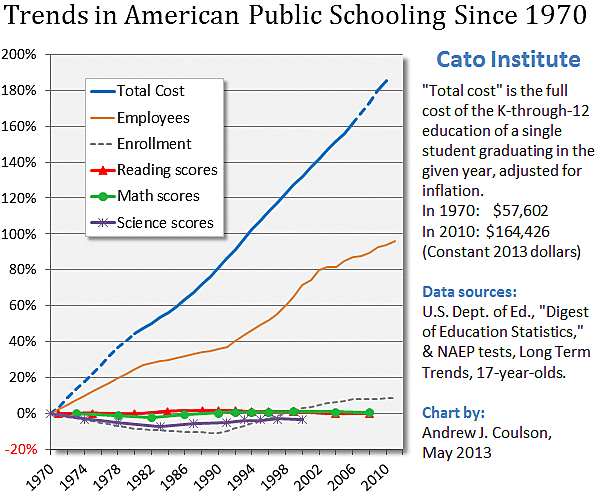There are two bills being debated currently in the D.C. Council regarding the reporting structure for the Office of the State Superintendent of Education in the District of Columbia. One suggestion is to have OSSE fall under the purview of the State Board of Education. This legislation should be dead on arrival since it reminds me of the terrible old days when the Board of Education contributed to our town having one of the worst run school systems in the country. No one wants to go back to those days.
However, the second proposal, authored by Councilmember Mary Cheh, comes out of more recent controversies around DCPS that arose four years ago. Beginning in November 2017, the traditional schools faced a trio of problems that came in quick succession. First, a study by WAMU and NPR found that many seniors attending Ballou High School should never have graduated. From their report:
“An investigation by WAMU and NPR has found that Ballou High School’s administration graduated dozens of students despite high rates of unexcused absences. WAMU and NPR reviewed hundreds of pages of Ballou’s attendance records, class rosters and emails after a DCPS employee shared the private documents. The documents showed that half of the graduates missed more than three months of school last year, unexcused. One in five students was absent more than present — missing more than 90 days of school. . . Another internal email obtained by WAMU and NPR from April shows that two months before graduation, only 57 students were on track to graduate, with dozens of students missing graduation requirements, community service requirements or failing classes needed to graduate.”
Then in February 2018, Deputy Mayor for Education Jennie Niles and DCPS Chancellor Antwan Wilson resigned after the D.C. inspector general had found that with Ms. Niles’ assistance one of Mr. Wilson’s children had bypassed the school lottery to gain admission to Wilson High School. She had been enrolled at the Duke Ellington School of the Arts but was not happy there.
That same month the Washington Post reported that OSSE had discovered that as many of half of the students attending the Duke Ellington School of the Performing Arts lived outside of D.C. but were claimed to be residents so the families would not have to pay tuition. The story stated that a lawyer at OSSE told officials in his organization to slow the fraud investigation “because of the risk of negative publicity during a mayoral election year.”
These incidents point to the problem of having OSSE report to the Mayor who also controls the traditional public schools. As Ms. Cheh indicates in her proposed legislation:
“However, in 2007, with the passage of the Public Education Reform Amendment Act of 2007 (“PERAA”), the SEO became the Office of the State Superintendent of Education, a change that came with much greater responsibility. OSSE took over a
number of responsibilities previously handled by the Board, including developing state-level standards and assessments, grantmaking, and, importantly, oversight of the District’s public schools. In addition, under PERAA, control of DCPS shifted from the Board of Education to the Mayor. For the first time, the District’s state level oversight body and its public school system were subordinate to the same person—the Mayor.
For this reason, OSSE is unlike any other state-level oversight body in the country. In every state, school districts answer to state-level education authorities, which are empowered to audit all school data and demand corrective action where an audit identifies areas of concern. In no other state does the state-level oversight body report to the head of a school system it oversees. This conflict of interest compromises the work of our Superintendent, risking the public’s trust in the integrity of our school data. Unfortunately, the effect of this conflict of interest on OSSE’s work is not merely speculative. In recent years, there have been concerning reports regarding OSSE’s oversight of our public school data, and failures to adequately identify errors or misrepresentations in data on student attendance, suspensions, and graduation rates. In these instances, it was members of the media—not OSSE—who identified these data issues and brought them to the public’s attention. In the normal course, such issues would have been identified as part of regular audits; that they were not raises genuine concerns about our audit processes and how OSSE oversees our school data. What’s more, at that time, it was reported that an OSSE attorney directed staff to delay a particular investigation because it was a mayoral election year.”
An independent OSSE would avoid the inherent conflict of interest that was established with PERAA’s passage in 2017.
I should mention that Shannon Hodge, the founding executive director of the DC Charter School Alliance, testified before the Council that she is opposed to both acts currently being debated about OSSE’s reporting structure. About Ms. Cheh’s suggestion she commented:
“Making OSSE an independent agency within the DC government, as the Office of the State Superintendent of Education Independence Amendment Act of 2021 (Bill 24-101) would do, would separate it from other agencies that it is deeply interconnected with. For example, OSSE and DC Health work closely together on a number of issues relating to the ongoing pandemic and need to be able to make coordinated decisions. OSSE simply needs the support and collaboration of every city agency to best accomplish their work.”
It is an unusual position because the new organizational structure of OSSE mirrors that of the DC Public Charter School Board. With the PCSB, the Mayor appoints the members but the body is run on its own. I say the council should pass this legislation.

You must be logged in to post a comment.